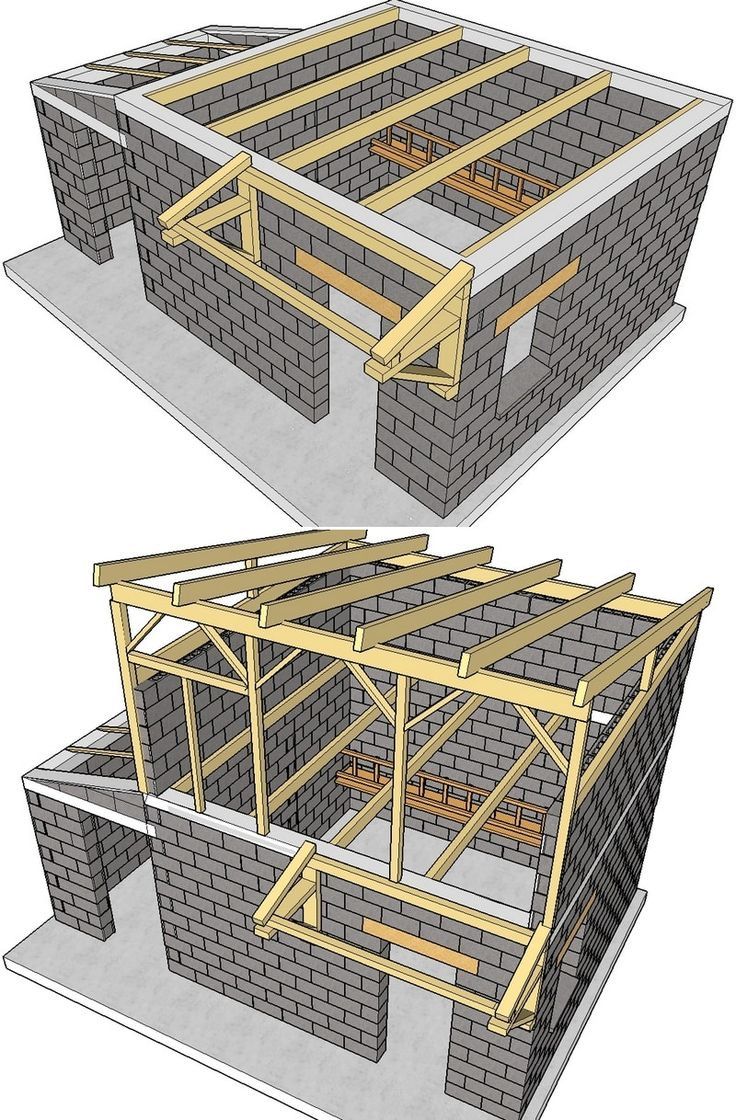
A set of construction diagrams clearly illustrates two methods for framing a flat roof on a masonry building, a style that has become synonymous with modern, minimalist architecture. The sleek, clean lines of a flat roof are undeniably appealing and are a popular choice for contemporary homes and additions.
But while the diagrams show how to build this style of roof, they don’t answer the more critical questions: should you, and where? The decision between a flat roof and a traditional pitched roof is one of the most important a homeowner will ever make. Choosing the wrong one for your climate can lead to a cascade of costly problems, from persistent leaks to catastrophic structural failure.
## Understanding the Flat Roof Option
The provided image shows two valid techniques for framing a flat roof. The first, a simple “cap,” involves placing roof joists directly on the building’s main walls. The second, a more complex method, involves building an elevated frame on top of the walls to create a higher ceiling before the roof is added. Both methods result in the same final product: a building with a flat, or very low-slope, roof.
The Pros of a Flat Roof:
- Modern Aesthetics: The primary driver of the flat roof’s popularity is its clean, geometric look, which is a hallmark of modern and contemporary design.
- Usable Space: A flat roof can be converted into valuable outdoor living space, such as a rooftop deck, garden, or patio—a huge benefit in dense urban areas.
- Equipment Placement: It provides a convenient, hidden space to place HVAC units, solar panels, and other mechanical equipment.
The Cons (and Critical Mistakes):
- Leaks are a Constant Threat: This is the number one drawback. A flat roof does not shed water quickly. It is designed to drain it, like a very shallow bathtub. If the waterproof membrane is punctured or the drains become clogged with leaves or debris, water will pool, creating immense pressure and finding any possible flaw to create a leak. This makes flat roofs a very high-risk choice for regions with heavy rainfall.
- Heavy Snow is a Major Hazard: In climates with significant snowfall, a flat roof does not shed the snow. It accumulates it. The immense weight of heavy, wet snow can exceed the structural capacity of the roof joists, leading to sagging, or in the worst case, a complete collapse. This makes flat roofs a structurally demanding and expensive option for heavy-snow regions.
- High Maintenance: Flat roofs require more frequent inspection and maintenance than pitched roofs. The membrane must be checked for cracks, punctures, or failing seams, and the drains must be kept clear.
## The Case for the Pitched Roof
The traditional pitched roof, with its familiar triangular shape, is a time-tested and globally proven design.
The Pros of a Pitched Roof:
- Superior Weather-Shedding: This is its greatest advantage. A pitched roof uses the simple power of gravity to shed rain and snow quickly and efficiently. Water has very little time to find a way in, making it the most reliable and low-risk design for regions with heavy rain or snow.
- Longevity and Durability: The materials used on pitched roofs—such as asphalt shingles, metal panels, slate, or clay tiles—are layered in a way that provides multiple lines of defense. These systems are incredibly durable and can last for decades with minimal maintenance.
- Creates a Ventilated Attic: The space created underneath a pitched roof, the attic, serves as a crucial thermal and moisture buffer for the home. A well-ventilated attic allows hot air to escape in the summer, keeping the house cooler. In the winter, it helps prevent the formation of destructive ice dams.
The Cons:
- Traditional Aesthetics: For those seeking a purely modern or minimalist look, a traditional pitched roof may not fit their stylistic vision.
- Lost Usable Space: The roof surface cannot be used as a deck or patio.
## Conclusion: Choose Your Roof to Match Your Weather
“The debate between a flat and a pitched roof is a classic case of form versus function,” explains Jennifer Miller, a (fictional) residential architect. “The sleek form of a modern flat roof is very popular, but it comes with a high-maintenance commitment and is a genuinely risky choice in climates that see a lot of precipitation.”
“A pitched roof is a nearly perfect, time-tested machine for dealing with weather,” she continues. “The most important advice I can give a client is to be honest about their local climate and their tolerance for maintenance. In a very dry, arid climate like the American Southwest, a flat roof can be a fantastic and durable choice. But in a place with heavy rain or snow, like the Pacific Northwest, New England, or much of Northern Europe, a pitched roof is almost always the smarter, safer, and more cost-effective choice in the long run.”
Ultimately, a home’s roof is its first and most important line of defense against the elements. While architectural style is a valid consideration, the final decision on your roof’s design should always be dictated by the reality of the weather it will face for the next 50 years.